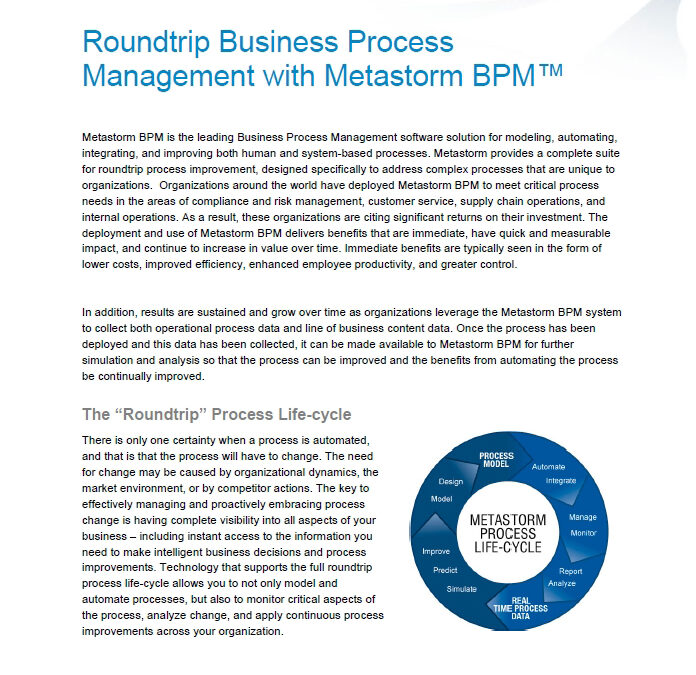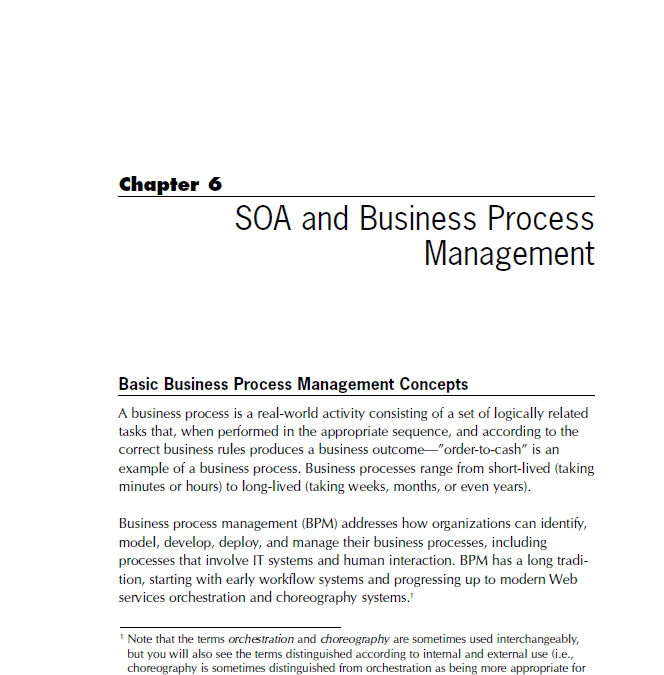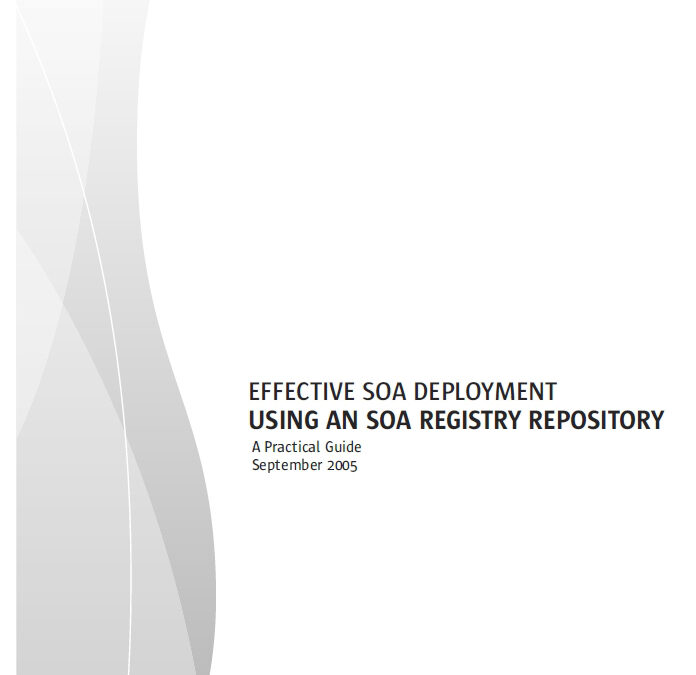Home / Resources
Resources
Discover a Wealth of BPM Knowledge and Expertise at BPMInstitute.org!
Business Analysis and SOA: The Benefits of Business Services
This is the first article in a six-part series dedicated to exploring how SOA and service-orientation relate to and affect business analysis processes and approaches.

Roundtrip Business Process Management with Metastorm BPM
There is only one certainty when a process is automated, and that is that the process will have to change. The need for change may be caused by organizational dynamics, the market environment, or by competitor actions. The key to effectively managing and proactively embracing process change is having complete visibility into all aspects of your business – including instant access to the information you need to make intelligent business decisions and process improvements.

The Virtues of Incrementalism
Because business process management provides a strong capability for business change, organizational and people issues are huge challenges. Adopting new technology places extensive demands on employees and their managers.
Teetering on the BPM Strategy Edge
Bischoff is an international expert on optimizing and automating business processes across silos and the extended enterprise. She also is recognized for her work in Web services, brand strategies, strategic planning, integration, and IT/organization alignment.
According to Bischoff, most organizations are in the “tactical” mode when it comes to BPM. In other words, they are still in the discovery phase when it comes to Business Process Management. Moving from the tactical model to strategic mode is the key to enterprise success and necessary when implementing BPM.

How Do You Use Enterprise Business Architecture (EBA)?
In the article titled Understanding Enterprise Business Architecture, the basic concepts and purpose of the Enterprise Business Architecture (EBA) were discussed. This second article continues the discussion and provides an overview of how to use the EBA. Just remember, the EBA is a model built with rigor and discipline, the same that is applied in the fields of engineering and construction. It is a formal model representing the business as a manifestation the strategy.

Just Enough Process Management
It’s easy to get caught up in the frenzy of doing something just to do it. We’ve all seen it happen. Companies who implement full blown quality programs, like Six Sigma, often find themselves lost in a myriad of unfocused green belt projects, unnecessary processes and mountains of paperwork. They did not comprehend the trickle-down impact such an implementation would have on the organization. Does that mean the program is bad? Absolutely not. But its implementation was not tailored to the needs and objectives of the company.

Avoid Compliance Silos in Business and IT – Leveraging Business Process Management
After responding to the first round of compliance requirements, businesses are now faced with a new set of internal challenges. They have come to realize that their control objectives are not always in line with business objectives. In fact, a number of businesses are experiencing additional compliance costs as a result of disconnects within their own organization.
Corporate compliance, now more than ever, demands an enterprise approach. A new level of collaboration between IT and business lines is required.

SOA and Business Process Management
The convergence of BPM, SOA, Web services, and XML promises to significantly improve corporate agility, reduce time-to-market for new products and services, reduce costs, and improve operational efficiency of IT systems. Chapter 6 from “Understanding SOA with Web Services” explores each of these technologies in depth and describes the pros and cons of the implementation of each. The authors also do a compare and contrast between orchestration and business process management including an examination of where BPEL falls short for BPM solutions.
Exclusive members-only chapter from:
A Holistic View of Business Rules and the Business Rules Approach
Business rules are not new. They exist in businesses whether some or all of the business is automated. Not all business rules may be automated. The generally accepted definition of a business rule comes from The Business Rules Group in 2000 as “a statement that defines or constrains some aspect of business intended to assert business structure or to control or influence the behavior of business.” The approach, the Business Rules Approach, is new in its formalism of managing rules and its emphasis on the business as a priority over the systems implementation.

Case Study: Managing Business and System Requirements for BPM-Driven Projects
Larry Ward is a Quality Assurance Project Manager in the OPERS Information Systems Division for the State of Oregon. He has more than 30 years experience in systems analysis & design, Industrial Engineering, Project Management, and QA. He has more than ten years of experience with the business rules approach. Ward was instrumental in designing the OPERS business rules process.

Analyzing the “As Is” Process
The first step in the analysis of a process is to create a process map or flow chart of the current state. This “as is” map represents what happens, not what should happen, or could happen. A useful technique when creating the “as is” is to recall an actual event. In remembering the event, what actually happened? This way you map reality.
The process map is the base from which the analysis begins. Process mapping can be done at three different levels of detail. The least detailed level (5000 foot) is called the Macro. At this level, your process map contains only 2 to 7 steps.

EAI, BPM and SOA
Traditionally enterprises grew their systems and IT infrastructure out of necessity as the business grew and connected the various IT applications with minimum planning. Stove pipe applications were pretty much the norm. These applications were connected in a point to point manner with no clear indication of process flow. But as the pace of business change accelerated connecting systems became a major roadblock. Then in the late 1990’s EAI (Enterprise Application Integration) emerged as a planned way to integrate the array of IT applications.

Your BPM Implementation is Bound to Fail
Failure is the Only Option
I can outright tell you that your BPM implementation is going to fail, and I will be right 9 out of 10 times. Is this scary?
Research has shown that even amongst IT projects only 20% of them finish on time. On BPM projects, the failure rate is even higher due to the immaturity of the technology and scope of the implementation. If you are implementing a BPM project with the current tools and using the current standards that are still in flux, you are on the bleeding edge of technology. So your failure rate is even higher.

BPMS Watch: Why Buy a BPMS When You Can Get it for Nothing?
Today’s BPM Suites are delivering on customers’ capability wish lists, but vendors are having a hard time getting buyers to put their money where their mouth is. Caught in limbo between IT infrastructure and an enterprise application, BPMS doesn’t fit traditional payback models of either IT or line of business investment, so it faces a heightened “prove-it” mentality from corporate buyers. But your CFO won’t go for the upfront six-figure outlay you need to demonstrate the payback is real. It’s a classic Catch-22.
OK, suppose the BPMS software were free. Free, as in costs nothing. Zero. Nada.

Enabling Business Process Innovation
Thomas Dwyer said that most of the problems companies have are due to process problems. These include:
BPM Strategy Deployment Best Practices
As BPM technologies and solutions mature, some organizations are now beginning to develop enterprise-wide BPM strategies. The most important aspects of an effective enterprise BPM deployment strategy are unrelated to the solution or even to the application being implemented. They’re best practices that apply no matter what software you’re using and regardless of the department in which you’re deploying it. Here are three best practices that we advise our clients to keep in mind as they move forward with their BPM strategies.
1.

Optimizing the ROI from BPM
Analysts widely agree that the growth rate of Business Process Management (BPM) software will continue in the double digits for the foreseeable future. Whether BPM deployments are making a significant contribution to a more customer-focused, process-centric management...

Three Keys to Enhancing BPM Implementation
If you’re moving up the ladder of CMM or just wanting to better manage your business processes, you need to consider more than which vendor software package to implement. Successfully implementing process management requires addressing all three aspects of the virtual trinity – people, process and technology. While the technology side of the equation is fairly well understood, the people and process side continue to bring challenges. In working with organizations across the country, I’ve found the following three concepts to bring most value in addressing these challenges.

Effective SOA Deployment Using An SOA Registry Repository
Today, Service Oriented Architecture [SOA] is being adopted by many IT organizations because it promises to make them more agile and efficient. This is possible, in large part, due to the loosely coupled nature of SOA, which enables service components to evolve without needing costly rework in existing deployments. Such agility and efficiency is also possible due to increased leverage and reuse of existing service components when building new service components.
Determining the ROI of Your SOA
While everyone is bound and determined to build an SOA within their enterprise–perhaps even between enterprises–few have attempted to determine their Return on Investment (ROI) to justify this approach and technology. True to form, we are again approaching new technology with fervor and excitement, but we also need to figure out the business case for this movement.













